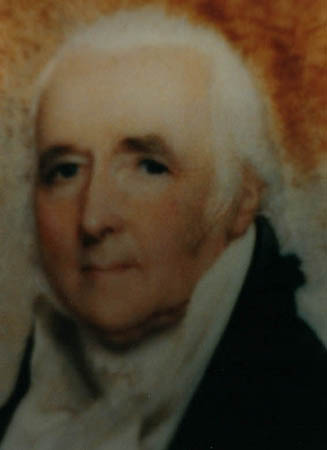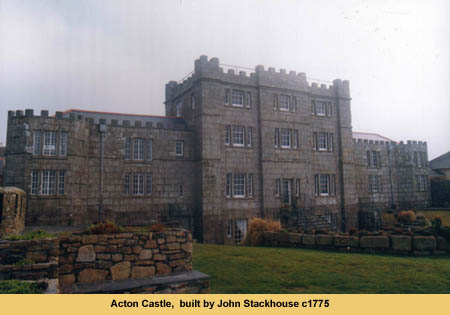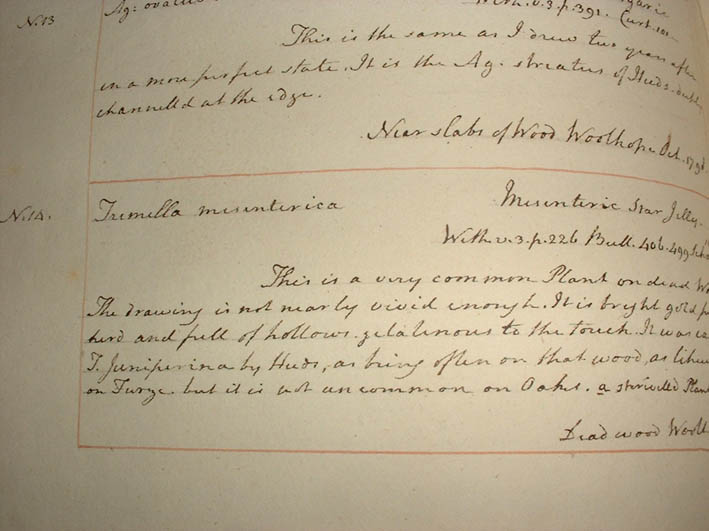John Stackhouse of Pendarvis
1742 - 1819
| Relationship to me: |
Great Great Great Great Grandfather |
Gen -6 |

John Stackhouse
date unknown
picture kindly given to me by Ian
Caldwell
|
| Born: |
1742 |
| Died: |
1819 |
| Age |
77 |
|
| Father: |
not recorded |
|
| Mother: |
not recorded |
|
| Brothers: |
None known of |
|
| Sisters: |
None known of |
|
| Married: |
Susanna Acton
m. 1773 |
1754 - 1834 |
| Children: |
John |
died young |
| |
Edward
William |
1775 - 1853 |
| |
Thomas
Pendarves |
1778 - 1835 |
| |
Anne Gregory |
1785 - 1862 |
| |
Catherine |
1790 - 19 Dec 1873 |
|
From Ian Caldwell: John Stackhouse was born at Trehane,
Cornwall in 1742, the son of Rev.William Stackhouse DD, rector of St.Erme,
Cornwall (d.1771) and his wife, Catherine Williams, daughter of John Williams
and Catherine Courtenay (who was descended from Hugh de Courtenay, 1st Earl
of Devon). John¹s uncle, Thomas Stackhouse, was a theologian who wrote
a "New History of the Holy Bible from the Beginning of the World to
the Establishment of Christianity."
On 20th June 1758 John Stackhouse matriculated
from Exeter College, Oxford and was elected to a fellowship of the College in
1761 but left the University when he succeeded to the Pendarves property in
Cornwall in 1763. He travelled abroad for two or three years studying marine
biology around the Mediterranean. His particular interest was in the study of
seaweed (see below).
Returning home he divided his time between the Pendarves estates
and St.Erme. Shortly before Christmas 1772 he  met and fell in love with Susanna Acton, the only daughter of Edward Acton
of Acton Scott in Shropshire. Early in 1773 he and Susanna took a boat out to
St.Michael¹s Mount and while they were there decided to build a house on
the coast between Perranuthnoe and Cuddon Point, partly for the view and partly
so that John Stackhouse could pursue his study of seaweed.
met and fell in love with Susanna Acton, the only daughter of Edward Acton
of Acton Scott in Shropshire. Early in 1773 he and Susanna took a boat out to
St.Michael¹s Mount and while they were there decided to build a house on
the coast between Perranuthnoe and Cuddon Point, partly for the view and partly
so that John Stackhouse could pursue his study of seaweed.
John married Susanna on 21st April 1773
and the couple lived in their large Georgian mansion where John pursued his
interest in Botany. He bought a lease on the land above what is now known as
Stackhouse Cove for £46 from the Trevelyan family of Nettlecombe in Somerset
and, as a sign of his love for his wife, Stackhouse requested and received permission
of Susanna's father, the use of the family name for the house he intended to
build. About 1775 he erected Acton Castle at Perranuthnoe
(photo right).
John was one of the early fellows of the
Linnean Society, being elected in 1795, and his published works include Nereis
Brittanica, or "A Botanical Description of the British Marine Plants in
Latin and English, Accompanied with Drawings from Nature", London 1795:
Bath 1801 folio etc.
In 1802 Stackhouse sold Acton Castle to Captain Bulkeley Praed,
previously Nelson's navigator at the Battle of the Nile. He sold the Manor of
Icomb estate in 1807. He died at his house at 4 Edgar Buildings, Bath, on 22nd
November 1819.
Note (from information provided by Jess Shepherd of the Plymouth
City Museum and Art Gallery - see email dated 24th Apr 2009):
Sir John St. Aubyn (1758-1839) was very good friends with
John Stackhouse. They lived in close proximity to each other in Cornwall,
Sir John living in Clowance and on St. Michael's Mount. John Stackhouse gave
Sir John some of his herbarium specimens in the 1790's and they have managed
to survive the past 200 years to end up in Plymouth City Museum along with
Sir John's other herbarium specimens. There is a mass of information at www.plymouth.gov.uk/museumstaubyncollection
- visit the "herbarium" tab on the left and then click on the database
to see Stackhouse's specimens. His are - Primula farinosa, Exacum filiforme,
Acorus calamus, Typha latifolia and Carex capitata.

Sir John St. Aubyn, Plymouth City Museum and Art Gallery Collection ©

John Stackhouse's Handwriting from his
book on seaweeds.
Ian Caldwell has kindly provided
the following extract relating to John Stackhouse's studies of seaweed from
a contemporary review of "Nereis Britannica" piblished in 1798:
Nereis Britannica; or a Botanical Description of British
Marine Plants, in Latin and English, accompanied with Drawings from Nature.
By John Stackhouse, Esq., Fellow of the Linnean Society. Number II. Folio. 12s
6d, Robinsons. 1797.
Having given an account of the first number of
this valuable publication (see our XVIIIth Volume, New Arr. p.419.), and not
only traced out the general plan of the work, but also illustrated its particular
mode of execution by exhibiting an entire article both in Latin and in English,
we now proceed to notice the prefatory discourse to this second fasiculus, which
is in fact a continuation and extension of the physiological observations on
the structure and fructification of fuci, contained in the preface to the first.
Having procured a good compound microscope, Mr.Stackhouse
began his new series of observations on the terminating fruit of the fucus serratus.
“Having found some of these in maturity,
which was evident from their yellow colour and a sort of semi-transparency,
and, likewise, from the apertures of the external tubercles discharging mucus
plentifully, I cut a transverse slice from the middle, and, having pared off
the internal skin on each side of a part of it, I placed the piece on the
field of my compound microscope fitted with the lowest power (No.6). I perceived
that the internal substance which appears glossy and colourless to the naked
eye, was in fact a beautiful network of capillary threads with orbicular masses
or granules of a different substance, darker coloured, and not reticulated.
These masses were either near the internal coat, or adhering to it, and were
furnished with five or six pear shaped seeds each. The external tubercles,
of which there were five in the piece under examination, had very sensible
apertures, as viewed under the glass, and communicated with the internal process.
Having made this discovery with my weakest power at first, to guard against
optical deception, I applied my highest powers (No.12.) to the same object:
with these I plainly perceived that the reticulated transparent fibres, or
threads, were in reality tubes forming meshes, and intersecting each other;
and furnished at intervals with transparent septa, or divisions.
“My next attention was paid to the fruit
of the bladder fucus in the same state of maturity. I cut a slice out containing
a part of the external coat, and some of the internal clear mucus, which was
solid enough to bear cutting, and submitted it to investigation under the
different powers of the above mentioned. The same internal structure was visible,
but much more beautifully arranged, which arose probably from the fruit having
its coats more expanded, and consequently affording more room on the inside.
In this, likewise, as the cut was made through the internal tubercle, the
passage from thence to the internal orbicular masses was very conspicuous.
Having met with F.bifurcatus of major Velley, the F.tuberculatus of Hudson,
and of the Linnean transactions, in full fruit, with the summits beautifully
transparent, and shewing the granules to the naked eye, when held up to the
light, I cut the summit down lengthways, and took out a slice, and submitted
it to investigation, and the internal structure was perfectly analogous to
those before described. I have had opportunities during the course of the
last year of repeating these experiments on these plants at my leisure, and,
likewise, of extending them to the fruit pods of the kindred species - F.nodosus,
F.spiralis, F.caniculatus, etc. I pursued the same mode of cutting a transverse
slice from the middle of the pod and was happy to find a perfect analogy in
their mode of fructification: the only specific distinctions I found, were
in the form of the meshes, in the size and shape of the seeds, and in the
number contained in each orbicular mass.
“A similar mode of fructification I observed
in some species of fuci, differing widely in habit from those already mentioned,
and not having an appropriate fruit-pod. Among these are to be reckoned the
F.loreus, a succulent plant with masses of seeds, and internal tubercles throughout
its whole length. This plant, on having transverse slices cut through it,
shews the tubular organisation and masses of seeds, but with this difference,
that the tubes, though occasionally intersecting each other, are in general
flexuous and wavy; the granules, or masses of seeds in this species, contain
from three to six each. F.tamariscfolius has its summits above the imbedded
bladder pretty much swollen at the time of fruiting, the the dissecting knife
discovers the tubular process, and the masses of seeds; F. caespitosus, a
very minute species recently discovered by me, has a similar fructification,
and it may be fairly concluded that many of the shrubby fuci do not differ
essentially from those already described.
“It having been hinted to me from high
botanical authority that the pear shaped bodies described and figured by me,
as they appear in the compound microscope, might not be real seeds, but only
gems, or particles of the medullary substance of the different plants; as
it seemed impossible from their extreme minuteness to dissect their component
parts with sufficient accuracy, in order to ensure conviction, I resolved
to procure, if possible, the spontaneous discharge of the seeds in sea water,
in order to submit them to a more accurate examination. I likewise conceived
the idea that I might close my experiment by sowing the seeds on sea pebbles,
and by alternate immersions and emersions procure seedling plants from those
seeds. I selected three species, viz, F.serratus, F.canuliculatus, and F.bifurcatus.
I carefully detached these plants with their bases uninjured from the rock,
and placed them in wide-mouthed glass jars with a change of sea water every
twelve hours. I the course of a week I succeeded in procuring the seeds, which
now appeared oval rather than pear shaped, and, when ripe, burst asunder transversely
in the middle with an explosion: these seeds were enclosed in a bright mucus
immiscible with sea water, and likewise specifically heavier than it; so as
to serve the double purpose of carrying them to the bottom, and of affixing
them to the rock when settled there by their gravity. This spontaneous discharge
of similar shaped bodies, all inclosed in a glassy mucus, and all opening
transversely, would hardly have needed the additional corroboration of causing
them to vegetate in order to evince their being actual seeds; this however,
I likewise happily accomplished.
As many curious persons, who occasionally visit
sea bathing places, may be desirous of ascertaining these facts under their
own eyes, I shall detail the experiments I made. Having procured a number
of wide-mouthed jars, together with a syphon to draw off the water without
shaking or disturbing it, on September 7, 1796 I placed my plants carefully
in the jars with their bases downwards, as in their natural state; on the
following morning I decanted off the sea water, and letting it subside in
the bason, I found a few particles at bottom, which, on being observed with
the microscope, appeared to be little fragments detached from the surface
b y friction in carriage. I then poured a fresh quantity of sea water on the
plants, and placed them in a window facing south: on the following morning
the jar containing the plants of F.canuliculus discharged into the bason a
few yellowing grains, which, on examining them, I found to be the actual seeds
of the plant; they were rather oval than pear shaped, but the most curious
circumstance attending the observation was, that each individual seed was
not in contact with the water, but enveloped with a bright mucilaginous substance.
It was easy to guess the wise economy of nature in this disposition, which,
as hinted above, serves a double purpose; each equally necessary towards continuing
the species. On the following morning a greater quantity of seeds was discharged
by this plant, and at the same time a few seeds were procured from F.serratus;
but this latter plant discharged such a quantity of mucous fluid, that the
sea water in which the plant was immersed was the consistence of thin syrup,
and, consequently, the seeds being kept suspended, it was difficult to separate
them. The seeds of F.canulioculatus, however, were numerous, and visible to
the naked eye, and, after letting the water rest for a few minutes, it was
no difficult matter, by gently inclining the bason to pour off the water,
and let the seeds remain. In performing this operation I was witness to an
explosion or bursting of one of these seeds or pericarps, which agitated the
water considerably under the microscope, and brought to my recollection the
circumstance mentioned by major Velley during his investigations of F.vesiculosus.
I at last obtained a discharge of seeds likewise from F.bifircatus; these
perfectly resembled the others. Having established this point, viz, that marine
plants scatter their seeds in their native element without violence, when
ripe, and without awaiting the decay of the frond, I next procured some sea
pebbles and small fragments of rock taken from the beach, and, after having
drained off the greatest part of the water in the jar, I poured the remainder
on the pebbles. I left them to dry for some time that they might affix themselves:
I then fastened strings to them, and alternately sunk them in water in a wide-mouthed
stone jar, and left them exposed to the air, in order to imitate as nearly
as possible the peculiar situation between high and low water mark, and when
the weather was rainy I took care to expose them to it. In less than a week
a thin membrane was discoverable on the surface of the pebble where the seeds
had lodged with a naked eye: this gradually extended itself, and turned to
a darkish olive colour. It continued increasing in size till at last there
appeared mucous papillae, or buds coming up from the membrane: these buds
when viewed in in the glass were rather hollow in the centre, from whence
a shoot pushed forth; in some instances they seemed to rise on a short thick
footstalk, and in this latter case resembled in some measure the peziza-formed
seedling of F.loreus (see pl. xii. A,B.), and the others without stems were
like the stemless pezizae.”
At the conclusion of the preface to the first
fasiculous a persuasion was expressed, that the families of these marine plants
would be properly arranged, and the discriminations of essential characters
would be prefixed to each, at a period not very distant; and indeed, the discoveries
of our author have enabled him to sketch out a new arrangement of the plats
hitherto, however discordantly, huddled together under the name of fuci. He
divides them into six genera, assigning to each genus its subordinate species,
according to the different modes of fructification. We shall present our readers
with the characters of these genera; but must refer them top the work itself
for the distribution of the species, and for a variety of curious particulars.
We are introduced to the new distribution by this remark:
“The anomaly that prevails respecting
the plants which constitute the genus fucus is confessed by every
writer, and however feeble the attempt here made to substitute a better arrangement,
it is hoped it may stimulate abler botanists to unite their labours, in endeavouring
to remove the opprobrium that rests on this part of the class cryptogamia.”
FUCUS |
| CHAR. GEN.- Fructification - mucosa, pellucida, granulis
sub-orbicularibus seminiferous intus: papillis conicus soratis extus-terminalis. |
FRUCTIFICATION - A jelly-like mass, with imbedded seed
bearing granules and external conical papillae - terminating. |
CERAMIUM |
| CHAR. GEN. - Fructificatio mucosa, pellucida, fine granulis
seminiferous: papillae invisibilius - per totam frondem. |
FRUCTIFICATION - A jelly-like mass, without the seed
bearing granules: internal, universal: papillae invisible. |
CHONDRUS |
| CHAR. GEN. - Pericarpium ovatum, immersum, utrinque
prominens: seminulis intus in muco pellucido. |
FRUCTIFICATION - An ovate, rigid, imbedded containing
seeds in a clear mucus, and prominent in either surface. |
SPHAEROCOCCUS |
| CHAR. GEN.- Granula seminifera sub-orbicularia; adnata
vel immersa; sessilia vel pedunculata. |
Fructification. - external globular pericarps, adnate
or immersed; sessile or pedunculate; containing seeds as above |
CHORDA
|
| CHAR. GEN.- Fructificatio mucosa in cavate frondis cylindricae:
seminulis glomeratis, nudus, cuti adhaerentibus. |
Fructification.- A mucous fluid in the hollow part of
a cylindrical frond, with naked seeds affixed inwardly. |
CODIUM |
| CHAR. GEN.- Fructificatio in tubulis implicatis - frons
cylindrico-compressa; status madido, spongiformis; sicco, tomentosa. |
Fructification.- Invisible; frond roundish; soft
and spongy when wet; velvety when dry. |
We afterwards met with a synoptic table of the
species arranged under their respective genera; and in the Latin preface, we
have a summary view of the recent discoveries of our botanist with regard to
the structure and fructification of the species figured and described in his
first fasiculus. His observations have convinced us that neither the air bladders,
nor the mucous glands opening on the surface, of the F. vesiculosus and serratus,
have any concern with the fructification, and that the pencils of fibres, fringing
the mouths of these glands are merely inspissated mucous.
This number contains the characters, synonyms,
descriptions, and coloured figures of twenty species, viz. F. saccharinus, phyllitis,
nodulis, loreus, filum, siculosus, tamariscifolius, osmunda, pinnatifidus, lacerus,
jubatus, stellatus, palmatus, edulis, caespitosus, corneus, crispus, echinatus,
sedoides, thrix. Ten of these are now figured for the first time, and four of
them are entirely new.
Whether Mr.Stackhouse’s arrangement of this
tribe of plants be or be not received by the generality of botanists, it must
be admitted that the attempt is worthy of praise; and the publication of his
synopsis will probably stimulate other cultivators of this science either to
aim at the improvement of his plan, or at the formulation of a new one; and
we hope that the discoveries which he has already made will ensure a continuation
of his zeal and diligence.
From a transient view of the species of fuci which
yet remain to be described and figured, we think it probably that a third fasciculus,
larger than the second, may complete the work.
Page updated 11 June 2009 - information added
relating to Sir JohnSt Albyn and John Stackhouse and their herbarium specimens
(thanks to Jess Shepherd).
Page updated 7 Sept 2005 - addition of extract relating
to John Stackhouse's studies of seaweed (thanks to Ian
Caldwell).

 met and fell in love with Susanna Acton, the only daughter of Edward Acton
of Acton Scott in Shropshire. Early in 1773 he and Susanna took a boat out to
St.Michael¹s Mount and while they were there decided to build a house on
the coast between Perranuthnoe and Cuddon Point, partly for the view and partly
so that John Stackhouse could pursue his study of seaweed.
met and fell in love with Susanna Acton, the only daughter of Edward Acton
of Acton Scott in Shropshire. Early in 1773 he and Susanna took a boat out to
St.Michael¹s Mount and while they were there decided to build a house on
the coast between Perranuthnoe and Cuddon Point, partly for the view and partly
so that John Stackhouse could pursue his study of seaweed. 